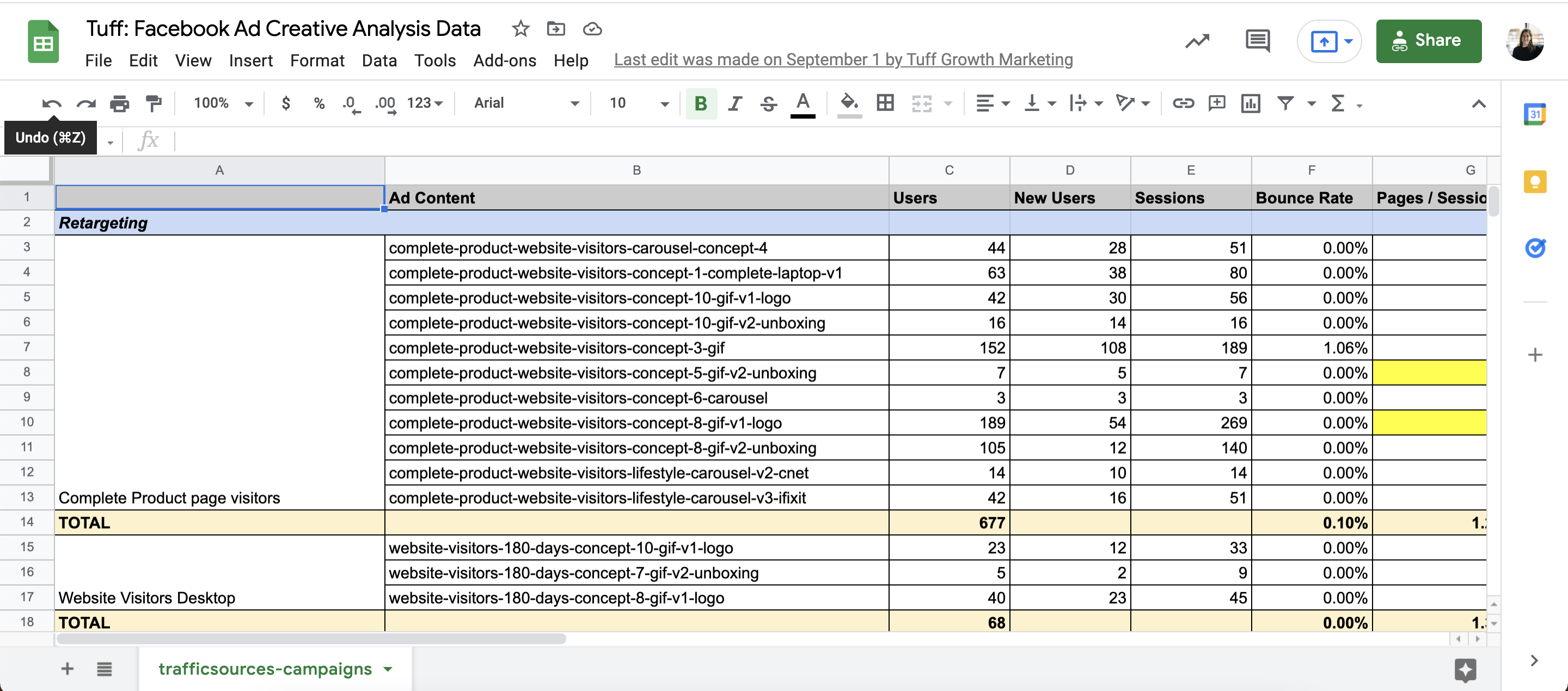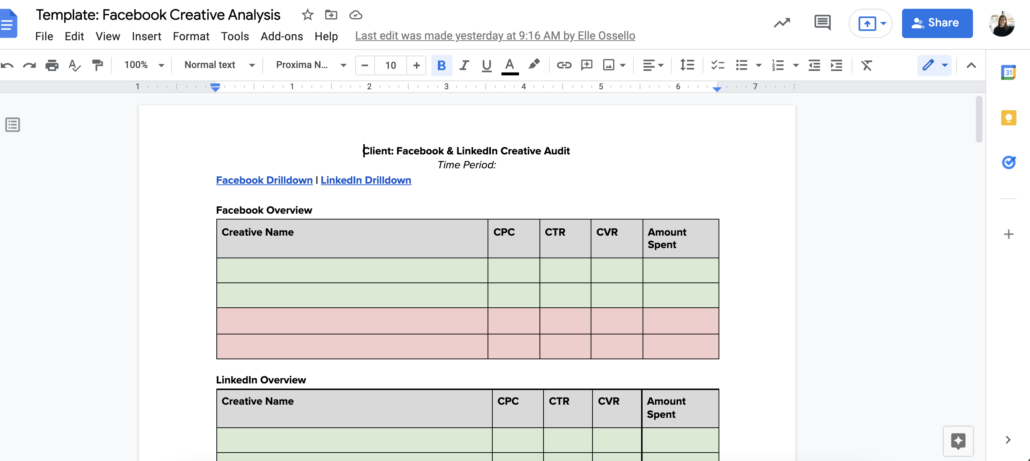Bow Down to Data: How We Use Metrics to Dictate Creative (+ Creative Analysis Templates)
“Do you make creative?” This is the question (that we got over and over again) that planted the seed that eventually bloomed into the creative department here at Tuff.
But, it was a question that we considered carefully before taking the plunge. There are a handful of other growth marketing agencies out there making “performance creative” but we knew that if we were to treat creative as an extension of our growth marketing services, we needed to make sure that everything we made answered to one queen: data!
So, that’s just what we did. And over time, we’ve built, refined, and perfected our creative analysis template and we’re excited to share it with you. It’s designed to hold our creative accountable—a way for us to make sure we axe the assets that aren’t contributing to driving clicks or revenue for our partners. And, ultimately, build out a suite of creative for our partners that centers on the stickiest messaging and drives the best possible traffic towards conversion.
Here are the two templates we reference in this article:
The Alternative: Slow-Moving & Expensive
Branding and creative-first agencies serve a definitively important purpose in the marketing world: a solid and cohesive brand has the power to instill trust and lay a great foundation. It’s also a powerful tool for building your employer brand. But, check out the H1 of our Creative page, and it’ll tell you everything you need to know about why our creative team is different: “Creative doesn’t have to be a production.”
We decided to take creative into our own hands after we, quite simply, realized that most branding agencies don’t have the tools or the in-house expertise to measure the actual effectiveness of their creative. It’s worth saying that almost every creative agency we’ve worked with (or at!) has incredibly insightful and talented people on their teams. But oftentimes, our growth team would submit a request for effective ad creative and, weeks (and sometimes thousands of dollars later) we’d get a file full of creative that, once we deployed it, had variable performance.
Additionally, with the rise of emerging platforms like TikTok, user generated content is consistently showing the results we’re looking for (case in point, one of our all-time favorite posts: Got a Crappy iPhone Video? You’ve Got the Perfect Facebook Ad). And, simply, UGC is a creative format that most traditional creative agencies aren’t set up to produce.
The Short List of Questions to Vett an Agency’s Ability to Produce Effective Ad Creative
- Do they measure the effectiveness of creative as a part of their process?
- Are they able to use data to justify their creative decisions?
- Are they invested in their creative actually driving measurable results for your business?
- Can they produce assets in a variety of formats?
Why We Do a Creative Analysis
Beyond simply knowing what kind of ads to make next, we perform a creative analysis once every four to six weeks and apply our learning to all other areas of our growth marketing strategy. When we can take a step back and identify patterns among our best-performing assets (like messaging, colors, imagery and even format type), we can extend our learnings to improve landing pages, email, and more.
One of our favorite tools we lean heavily on whenever we’re strategizing new messages to test or new creative to make is the Value Props worksheet. At the outset of every partnership, we’ll fill out this worksheet and, originally, use it as a level set to make sure that the ways we’re planning to articulate points of differentiation and value aligns with the expectations and insights of our partners’ teams. But, creative analysis exercises help us treat this as a living document; consistently tweaking and refining it to reflect the messaging that’s driven the absolute best results.
Beyond making the creative objectively better, the creative analysis exercise is a tool we use to also keep us laser focused on our main goal: drive results for our partners. And, when we center data in all of our creative work, it keeps the full creative team ego-less and unified.
How We Do a Creative Analysis
This is where left brains and right brains unite! Here’s how we conduct a creative analysis step by step.
1. Pull the data
When analyzing results, there are a lot of variables to take into account. Depending on the objective of the campaign, we will pull different data points to check out performance. We look at Facebook for metrics like cost per link click, click-through rate and amount spent and then look deeper into user behavior in Google Analytics for metrics like time on site, bounce rate and pages/session. This is where organized naming conventions come in handy! When working in Google Analytics, we add a secondary dimension of the ad content and then use the advanced filter to look at the data by creative asset and audience. Not only is it crucial to look at creative performance but it is also crucial to understand audience performance and why certain messages resonated with certain people.
If we are analyzing video content, we also take a peek at how much of the video users watched, when they dropped off and what the messaging was before.
2. Analyze the findings
Sitting among a suite of growth marketing tactics and strategies, creative is its own unique beast. So, analyzing the data and coming away with insights that can incrementally improve results can be a bit of an imperfect science. Sometimes the results are obvious: like motion outperformed stills. But other times, the takeaways aren’t as clear.
This is where it helps to enlist a creative brain (or two) to take a step back, and check out the spread. Here, it’s all about finding distinct patterns/similarities among the top performers. While it’s not always comprehensive (and sometimes necessitates a deeper look) check out our quick list of questions we ask to help us compare the top performers with the underperformers:
Among the top performers…
- Which messages are featured? (Revisit the value props sheet here)
- What creative format do we see? (Carousels, videos, GIFs, etc)
- What kind of imagery do we see? (Lifestyle, illustrated, portraits, etc)
- Is there a color pattern? Is one brand color featured more prominently?
- Are there any other noticeable shared elements? (humor, testimonials, offers, etc)
3. Create a game plan for a fresh round
Here’s where it all comes together! Once you’ve got your list of findings and your full team (including your partners) are in general agreement about the patterns among the top and bottom performers, it’s time to outline a game plan for the next round.
Again, this is where it’s handy to have a creative brain on your team to synthesize all of these findings and create a fresh brief that lays the groundwork for new concepts and ideas that uplift what’s working, ditches what’s not, and introduces a few new ideas to layer on. Over time, and after a handful of these exercises, you’ll have a growing list of messaging, creative formats, imagery, colors, and other shared elements that you know are going to generate the results you want to see.
Creative: It Can and SHOULD Bow to Data
If there’s one major takeaway from this article: there’s no room for creative egos when it comes to making ad creative that uplift growth marketing strategies. Even the most amazing, high-quality, expensive video can simply flop. And that stings. But instead of allocating more spend, trying new audiences, and trying to coerce some performance, sometimes (most often) the right course of action is to just scrap it and try something else!
Ready to get ruthless with your creative and see real results? Let’s chat!








